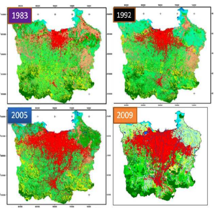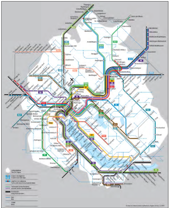
Integrating Public Transport Networks to Overcome Jakarta Traffic Congestion
Mobility is increasing both in Jakarta and the suburbs. In Greater Jakarta, travel reached 47.5 million trips/day in 2015, only 2 percent of which uses public transport. Public transport ridership remains low at about 19.8 percent in Jakarta and 20 percent in the suburbs. This results in severe congestion in Greater Jakarta, which costs Rp100 trillion in 2017. One of the government’s solutions to address the congestion issue is by establishing Mass Rapid Transit (MRT) and Light Rail Transit (LRT). Unfortunately, MRT/LRT alone won’t be enough to overcome congestion in Jakarta. Complementary policies to address the issues of limited network, land use sprawl and costly infrastructure are required.
First, the capacity of MRT/LRT remains far below its full system capacity with a passenger target of 173,000 and 360,000 passengers per day in the MRT/LRT construction (phase I). This is equal to 1 percent additional public transport capacity in Greater Jakarta. The actual capacity may be even smaller considering most of the users will be transferred from the existing public transports. That was the case with the Jakarta Bus Rapid Transit (BRT). About 71.9% of its users are transfers from conventional buses. MRT/LRT may face the same issue in accommodating greater number of passengers and attracting private vehicle users.
Second, the land use sprawl with limited public transport access and network coverage. The rapid population growth in Jakarta has resulted in land use sprawl to the suburbs, which tend to be low cost and car oriented. This is worsened by the lack of access and network coverage in the area. Study proves that only 44 percent of Jakarta residents live near a transit terminal. For the suburban residents, the number is even lower at 16 percent. Empirical evidence shows that public transport can attract higher volume of passengers when planned as a unified network to support seamless multi-destination travel rather than individual routes. The planned development of MRT/LRT network will increase coverage, but the spatial challenge remains and network expansion is costly. Integration with existing public transport network may be the answer.
Public Transport Integration

Fig: Land Use Change in Greater Jakarta in 1983 - 2009.

Fig: Zurich Regional Public Transport Network.
An example of advanced public transport integration can be found in Zurich, where a network of radial rail and tram lines are integrated with the more dispersed network of bus lines. Such integration could also be implemented in Jakarta. The integration of MRT/LRT with BRT offers the benefit of wider network, large capacity and lower cost. But first, the government has to accelerate the BRT network expansion to the planned total of 47 corridors. The current 13 BRT corridors that currently exist in Jakarta since 2004 are not sufficient to accommodate 380,000 passengers per day in 2016.
| MRT | LRT | BRT | |
|---|---|---|---|
| Construction cost (Rp/Km) | 767 billion – 1.24 trillion | 500 – 600 billion | US$1 million or equal to Rp12,4 billion |
| Corridor Length (Km) | 116.5(Planned) | 81.6(Planned) | 221.6(Existing) |
The integration of public transport requires good infrastructure. Multimode terminals should be constructed as a point of transfer between modes and interchange between networks. The key to a successful integration is the location of multimode transport, which needs to accommodate a large concentration of population or activities and land availability such as for parking. Based on the requirements of high density (more than 26,000 people/Km2), at least 2 modes of transport, and land availability for parking, there are 4 potential locations for multimode terminals.
Multimode terminals should offer high accessibility to multiple destinations, which will be available when more BRT routes are added. Terminal infrastructure can also be enhanced with additional platforms and dual lanes for BRT to make boarding and bus transfer easier and faster. Studies in Bogota (2013) show that BRT capacity can be enhanced beyond conventional buses’ through advanced facilities such as multiple platforms, multiple lanes and pre-payment in BRT stations.

Another MRT/LRT integration option is with conventional buses like Kopaja/MetroMini. According to the BPTJ map, most BRT routes still overlap with conventional bus routes, which may explain the transfer of conventional bus passengers to BRT. Re-routing conventional buses from uncovered areas to MRT/LRT stations will increase network coverage. Quality and managerial improvements must follow however, to enhance the comfort and safety of conventional buses.
Towards A Compact City
While the expansion of public transport network is crucial, the underlying spatial issue needs to be addressed. The development of Jakarta should be oriented towards a compact city. The government should focus on halting the sprawl and concentrating settlement density in Jakarta by expanding on buildings and floor space ratio.
Study shows that in a compact city like Madrid where urban density is 10 times higher than Atlanta, GHG emission is four times lower as public transport use is significantly higher. Higher density means larger concentration of potential passengers, which increases the viability of urban transportation infrastructure investment. Today, about 70 percent of Jakarta land area is low-density settlements. Therefore, densification in Jakarta is possible and should be integrated with public transport network, taking into account cultural perceptions, building standards and better land registration system.
MRT/LRT construction alone will not solve the current spatial issues. Jakarta needs a wider public transport network with better integration. The expansion of public transport network and a more compact spatial utilization in Jakarta will hopefully be able to tackle Jakarta’s urban transportation issues.